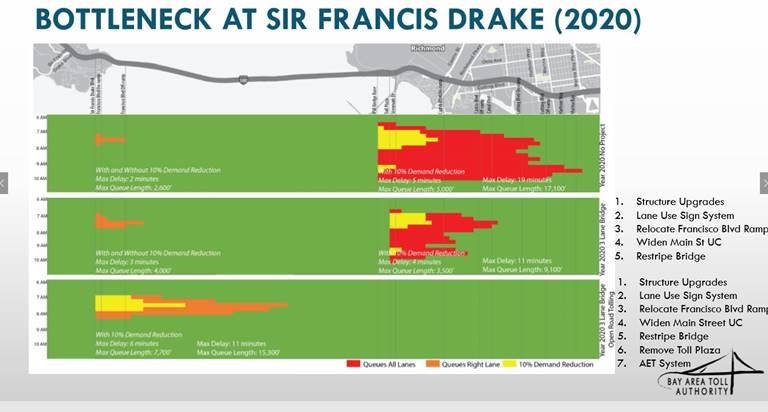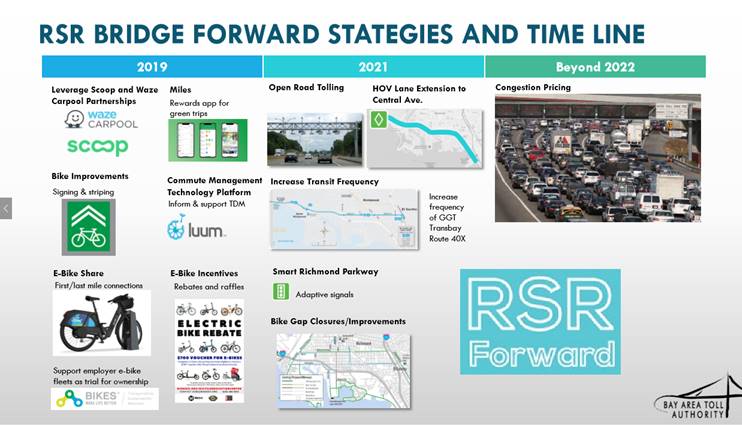|
| Those pesky and uninformed but know-it-all Marinites are at it again. See the editorial by Dick Spotswood below (“Columnist Dick Spotswood of Mill Valley writes (in the Marin IJ) on local issues Sundays and Wednesdays. Email him at spotswood@comcast.net”).
Spotswood joins a number of other uninformed Marin amateur traffic engineers who believe opening the third lane westbound on the bridge is a panacea to eliminate the morning rush hour backup at the toll plaza and want to end the four-year pilot project after its presumed failure in six months.. See Marin County Continues to Undermine Richmond-San Rafael Bridge Agreement, January 29, 2019.
Dick, I hate to tell you this, but it ain’t gonna happen. Get over it, and join us in seeking real solutions, including maybe building some worker housing in Marin.
On February 6, a number of us, including Supervisor Damon Connolly and TAM Executive Director Dianne Steinhauser, met at the MTC office to discuss the recent publicity surrounding the proposed shortening of the pilot project form four years to 6 months.
One thing we all agreed on was that adding the third westbound traffic lane was not going to happen in six months or even years, regardless of how many bicyclists use the bike lane, scheduled to open in April or May of this year.
Here is why:
- There is a serious question about the structural capacity of the bridge to carry a total of six lanes of motor vehicles. Although the bridge was originally designed to carry six lanes of traffic, it was designed nearly 70 years ago to now-obsolete engineering standards. Until last year, the bridge carried only four lanes. Opening the eastbound third lane last year added 25 percent to the live loads. Opening a third westbound lane would raise that to 50 percent, including the already added eastbound lane. Opening the third westbound lane will require an extensive engineering structural study, which even if started now would not be completed in six months.
In addition to design capacity issues, there is the 70 years of deterioration and corrosion, examples of which we saw earlier this week when the bridge was closed for a day because of chunks falling from the concrete roadway.
- Recent preliminary studies have shown that opening the third westbound lane would simply shift the morning congestion from Richmond to San Rafael. In the illustration below, the middle graphic shows what would happen with three lanes westbound, even with the addition of significant (time consuming and expensive) roadway modifications at the west end. The maximum delay is reduced from 19 minutes at the toll plaza and 2 minutes at the west end to 11 minutes at the toll plaza and 3 minutes at the west end, a net reduction of only 7 minutes. On the east end, we would have two Richmond Parkway lanes and three I-580 lanes squeezed to three lanes on the bridge, still causing a backup at the toll plaza. On the west end, there are two lanes on I-580 and one lane on Sir Francis Drake. The problem is that more than half the eastbound traffic exits on Sir Francis Drake, which would increase congestion at that point.
The lower scenario shows that eliminating the toll plaza and using open road tolling, like the Golden Gate bridge, will eliminate the toll plaza backup but largely shift congestion to the west end of the bridge. The maximum delay would be 17 minutes, only 5 minutes less than it is now.

- In addition to the physical changes required to open the third westbound lane, there are regulatory and procedural challenges. It would have to be approved by Caltrans, MTC and BATA, as well as BCDC, to name few. It would probably require CEQA review. The process would take years.
There are, however, some changes that can be done quicker and cheaper with greater effect. The yellow portions shown in the chart above show the reductions in delay from a 10 percent demand reduction. One way this could be done is by moving 200 people into 4 buses, 150 more HOV2+ carpools and 50 cyclists. Adding Richmond to Larkspur and Sausalito ferry service could also take cars off the bridge. In the first two weeks, the new Richmond ferry transported over 10,000 people to and from San Francisco, presumably taking thousands of cars off I-80.
It would also help if Marin County would provide the same type of bicycle and pedestrian facilities and connections on the west end of the bridge that Richmond is providing on the east end. Marin has delayed and defunded bike trails at the west end while Richmond is building a first class system at the east end.
What we need to do is to continue to collaborate with our Marin neighbors and find real ways to improve mobility while reducing congestion, such as are shown in the graphic below, instead of obsessing over the third westbound lane.


Dick Spotswood: Six-month bridge bike lane test makes sense
By Dick Spotswood | spotswood@comcast.net |
February 9, 2019 at 10:00 am
The Transportation Authority of Marin made a good move recently when it voted to urge the Metropolitan Transportation Commission to shorten its “test” period from four years to six months for the under-construction bike lane on the Richmond-San Rafael Bridge’s upper deck.
It followed the lead of Supervisor Damon Connolly, whose idea is that after a half-year trial, if peak period cycling across the San Pablo Bay span is low, the lane’s movable barrier should be shifted to allow westbound autos, buses and trucks to use the lane from 5:30 to 10:30 a.m. on weekdays. The remaining 143 hours a week would be reserved for cyclists and the hardy souls who’ll hike the 5.5-mile windy crossing and its approaches. That’s a fair compromise.
TAM”s board, composed of Marin’s five county supervisors and a representative from each of Marin’s 11 incorporated communities, voted 14-2 for Connolly’s compromise. The “no” votes were from Novato’s Eric Lucan and Fairfax’s John Wright.
It’s a loud message to MTC that at least one county cares about the tens of thousands of mostly East Bay-originating commuters forced to endure a 22-minute wait due to lack of a third westbound bridge auto lane.
According to TAM projections, in 2020 the delay will be 27 minutes. Even the Marin County Bicycle Coalition hasn’t formally endorsed the Richmond bridge bikeway, only saying that it doesn’t oppose it.
Outside of East Bay cycling activists, the push for 24-7 use of the cycling lane comes from MTC, whose Utopian hope is the Bay Area will someday replicate cycling in flat-as-a-pan Amsterdam.
The bridge bikeway is faith-based transportation planning. There’s no evidence that many cyclists will commute from Contra Costa to Marin. That’s because MTC refused to conduct a bike usage study. Their fear was if ridership was shown to be embarrassingly low, a multi-million-dollar bridge bikeway would have been a non-starter.
There’s plenty of hard evidence how many motorists and bus passengers will be delayed unless the upper-deck third auto lane is reopened.
As the IJ reported, once the lower deck’s third lane was inaugurated during peak periods, eastbound commuters saved 20-30 minutes. Keeping thousands of motorists and bus passengers backed up so a handful of cyclists can glide across the span is a net loss for the planet. Getting commuters out of single-passenger autos and into transit is a fine goal. Instituting East Bay-Marin ferries and a Vallejo-Novato rail link makes more sense than wishing substantial numbers of working people will make the cross-bay trek by bike.
TAM acknowledges a study is needed to guarantee the bridge can handle both additional vehicles and the cement and steel movable bike barrier, and down-the-road traffic implications must be considered. That wasn’t a problem during the 21 years the upper deck operated with three auto lanes, but traffic has substantially increased in intervening decades.
Reserving the bridge third lane for bikes 85 percent of the week creates a useful recreational amenity and makes a Bay Trail surrounding the bay region a reality. To ignore the needs of working people by refusing to allow them to drive the upper deck’s third lane for 15 percent of the week is greedy.
Credit Assemblyman Marc Levine, D-Greenbrae, and Sen. Mike McGuire, D-Healdsburg, for striving behind the scenes to facilitate Connolly’s compromise. Opposition comes from Contra Costa politicos willing to let their constituents sit and fume in traffic. Richmond Mayor Tom Butt adamantly opposes the compromise, demanding the full four-year “test” be completed no matter how few cyclists cross the bridge during peak periods.
Oddly, if Butt’s view prevails, the vast majority of commuters penalized won’t be Marinites; they’ll come from the East Bay.
|

